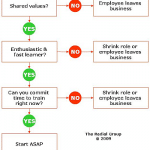Using social media to connect fitness clubs with leads, followers and members takes more than setting up a Facebook, Instagram or Twitter account and sharing overworked memes, quotes, and deals-of-the-week. Here’s how to grow your online following organically and authentically.
1. Join existing communities of common interest
Chances are good that potential clients for your obstacle-based Ninja Training Camp are already congregating online and talking about obstacle course races. You’ll normally find people talking about shared interests on:
- Facebook groups and pages dedicated to their interest
- Popular blogs, often run by someone who’s a passionate enthusiast
- Specialized sites with active message boards.
Talk to your members and use Google to identify the online venues where the kinds of people you want to reach discuss training, fueling, and upcoming competitions. For example, Facebook has a “Colorado Obstacle Racers” group with 2000+ members and an “All Things Obstacle Course Racing” group with nearly 8000 members.
2. Provide encouragement, support, and information
People who participate in online communities want:
- Basic information — how to get started, where to get necessary apparel, gear, supplies
- “Pro tips” and expert advice from people who have already done it
- Connections to “someone who gets me” and understands the highs and the lows
- Insight from the trenches — practical advice for overcoming bumps in the road
Nothing establishes your credentials, creates trust, and engenders a desire for follow-up like providing tidbits of expert advice — just enough information to establish your expertise as credible.
Look for opportunities to share the kind of information that will help people believe in themselves, progress to the next stage in their fitness objectives, seize opportunities, overcome hurdles, and become more knowledgeable.
Once people start seeing you as an objective expert on topics of interest to them, the “attaboys” and “attagirls” mean so much more, and you’re on your way to establishing a potentially revenue-generating relationship with some of the group’s posters.
If you’re new to the group, take time to build your credibility. You may be an expert, but others don’t know that — and you don’t want to get crosswise with the group’s graybeards / admins or you’ll be unwelcome. Hold back on immediately offering advice at times; not all opportunities for engagement are equal, and not only will you learn more as you listen, but you’ll develop an affinity with the regulars and mentors so that they think of you as one of their own.
A key point: don’t confuse your own advice with the rule of law. The last thing a mentor or regular wants to hear is some self-described guru telling them they’re wrong — even if they are. Since it’s a community, you have to be willing to be a good neighbor and let some arguments just slide off your back. Being right all the time will not help you develop leads.
P.S.: Blatant pitches are an absolute no-no.
3. Target your engagement
You’ll notice a variety of personas tend to exist in online communities dedicated to health, fitness or wellness. Who are you really trying to reach? Target your posts and comments to that audience.
- Researchers — just looking for some information, haven’t decided to commit to the activity yet
- Lurkers — Definitely interested in the activity but a little overwhelmed and would rather watch the existing conversation
- Newbies — first-time posters, probably asking questions that have already been asked, but actively engaged in the community
- Regulars — People who call the community “home”, visit it near-daily, and post fairly frequently on newbie threads, but acknowledge they’re not experts; this is usually the largest percentage of members
- Mentors — A smaller group, usually composed of founding or long-time members of the community, who have “been there, done that” enough to offer generally trustworthy advice if the question hasn’t been asked a million times already
- Wizards — Members who have usually been around the longest, know the most, and seldom post, but when they do, others listen; also usually the group ‘s admins
Researchers and lurkers want information about what to expect, how to get ready, and how to avoid basic problems. Newbies want quick, focused bite-sized tips — don’t overwhelm them! They’re committed to the activity, but they need early successes to stay committed. Regulars — by far the largest group of members — will be most likely to see the unique value of your services. They’ve tried all the free advice, and they’ve seen that it’s often worth what they paid for it. They know you’re an expert, they see the value in your knowledge and expertise, and they’re willing to pay you for it.
Keep in mind that group mentors and wizards can also become brand champions if you provide great programs for newbies. They love to see people who are new to the fitness activity embrace it and succeed. Alternatively, if you offer programs or services tailored to their own advanced level of experience, you’ll find that they often have a real appreciation for specialized expertise.
No matter who you connect with, you know they’re a legit prospect when you say “PM me” — and they do.
4. Turn supporters into champions
A small percentage of your community members will become real disciples. They will:
- Sing your praises on existing groups — something they can do much more credibly than you can, without seller bias
- Brag specifically on your products or expertise in a way that would seem self-congratulatory or vain if you did it
- Post positive reviews and commentary on your behalf at Facebook, Yelp and NextDoor
- Loyally engage in whatever you have going — for instance, signing up early for new classes because “they know it will be great”
- Offer testimonials and other promotional help
- Defend you if you’re slammed by negative reviews from others
- …and more
For those who become clients or members, look for opportunities to reward your most loyal customers. Then, take it one step further, and train them to be a brand ambassador.
They’ll do the work of building your following better than you alone ever could.
5. Build your own community
Sometimes the community doesn’t exist… yet.
When you set up your new community — for example, a new Facebook group or page — focus it on your prospects’ interests, not your products and services. A community of interest is different from your business page or website. Ford Mustang is not a following, and not a community. Ford Mustang World and Modded Mustangs are.
Set up your community with that in mind.
Give a handful of trusted connections admin control, ideally people who are already recognized as mentors and wizards. These may be trusted members at your club, current or former clients, or simply like-minded enthusiasts in this particular area. Their role in your community is to invite new members, vet who’s added to the group (or removed), and share their expertise and insights to get the conversation rolling.
This approach “nucleates” (provides a starting point for) your club’s following so that it builds more quickly. After all, half a dozen connections between them know far more people than you alone. And odds are, the people they know are just like them, which means they’re likelier to be a good fit for your business someday.
Successful communities are built around:
- Individual needs and motivations shared among members (Shortboard or longboard for surfers? Is heavier or lighter better?)
- A shared interest or purpose that unifies individual goals (an endurance swim group that includes people training for aquabike events, triathlons, and ultra swims)
- Unique mix of interests, concerns, and expertise levels (ocean-based stand-up paddleboarders who want to discuss dealing with surf, swells, and riptides)
They aren’t fan clubs for your wellness business or soapboxes for your opinions. They’re also not sneaky sign-up sheets for your next bootcamp.
As your group grows, more specific sub-groups will probably spin off, led by other people. Don’t view that as competition for your group. If you have relevant programs or services, it’ll be natural for your club to participate in that group, too. Either way, your group will have established itself as the taproot.
And are you really ONLY about your products and services? Or about helping people create a new life they’re excited to live?
We thought so. Now go out and build that following!
Want to know more? See our article, The New Rules of Search and Social.



